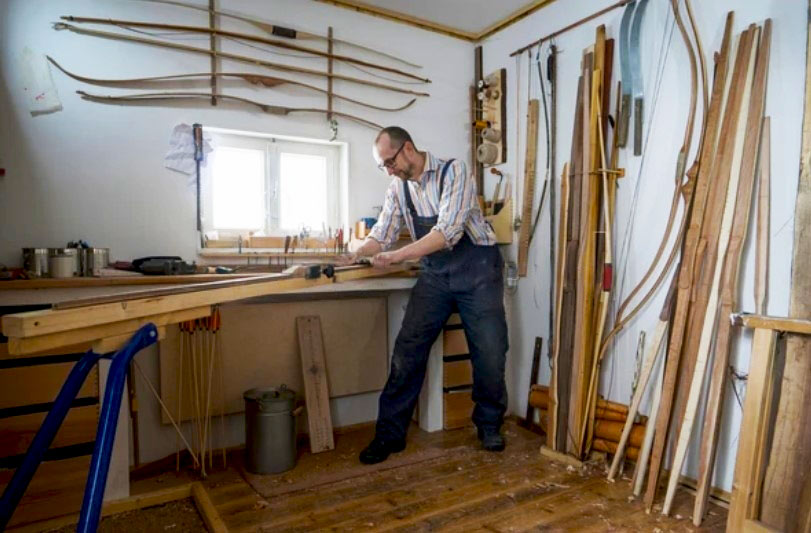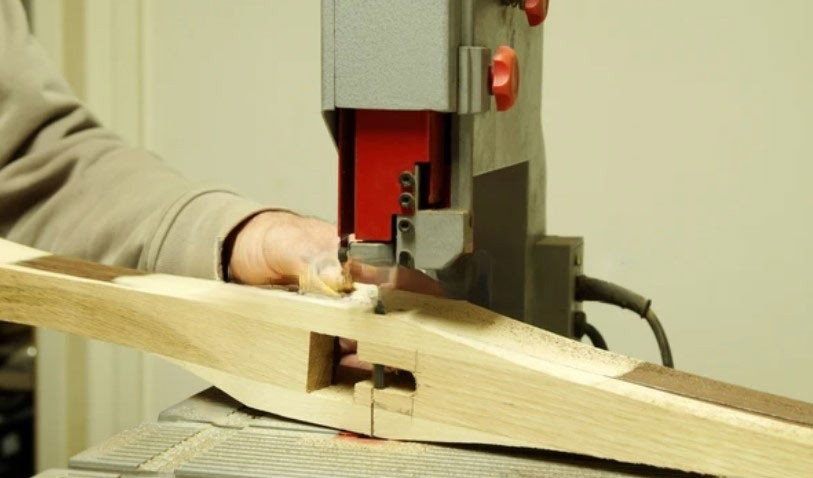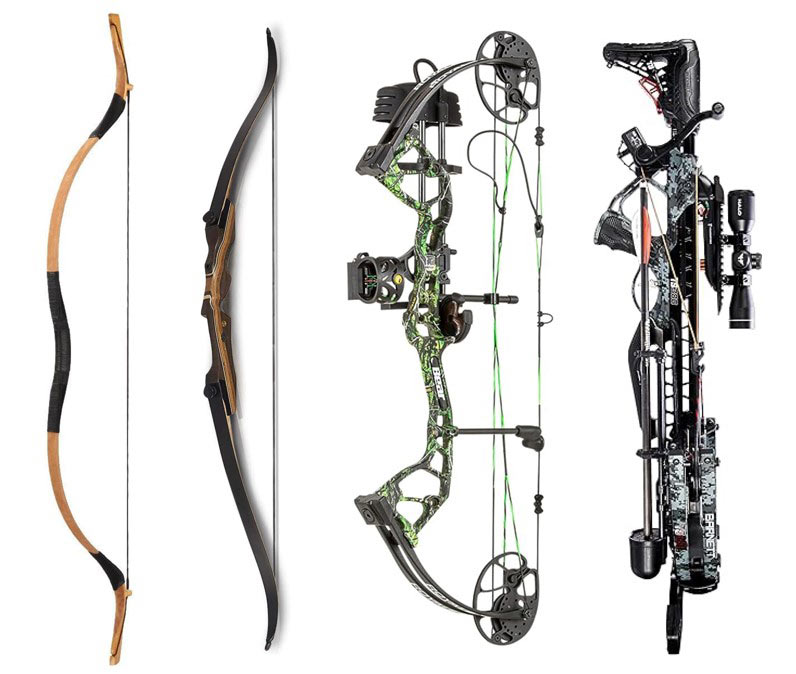Welcome to our blog post about bow wood for shooting! Whether you’re an experienced archer or just starting out, it’s important to know the importance of choosing the right wood for your bow.
We’ll talk about the different types of wood used for shooting bows, how to choose the best wood for your needs, and how to keep your bow wood in good condition.
So let’s get started and learn everything you need to know about bow wood for shooting!
Your Archery Bow Wood

Choosing the right wood for your bow is important if you want it to perform well. Different types of wood, such as yew, maple, and bamboo, have their own advantages that you can use to improve your shot.
When choosing the right wood for your bow, think about its strength, flexibility, weight, and how you like to shoot.
This will ensure that your bow lasts a long time, is accurate, and gives you a good experience overall.
Popular Types of Bow Wood
Yew wood is a popular choice for bow-making due to its flexibility and strength. Its unique grain pattern adds beauty to the finished bow, making it highly sought-after by archers.
Maple wood is another common type of bow wood known for its durability and responsiveness. It provides excellent performance and stability, making it a favorite among recurve bow enthusiasts.
Osage orange wood offers exceptional elasticity, giving the bow good power and speed when released. Its vibrant golden color also makes it visually appealing.
Factors to Consider When Choosing Bow Wood
When selecting bow wood, it’s important to think about how strong and flexible it is. The wood must be strong enough to hold up to the pressure of the shooter while still being flexible enough for a powerful shot.
Density and weight also play a role. Woods that are lighter can make arrows move faster, but woods that are thicker are more stable and accurate.
Lastly, you shouldn’t forget about supply and cost. Make sure the bow wood you choose is easy to get and won’t break the bank.
Pros and Cons of Different Bow Woods
Yew wood has been used for making bows for a long time because it is strong and works well. It moves energy well and shoots easily, but compared to other types of wood, it can be quite expensive. On the other hand, maple wood is strong and inexpensive, which makes it a good choice for newbies. It works about as well as Yew and is easier to work with.
Lastly, Osage orange wood is great for moving energy, but it is hard and can be hard to work with.
Choosing the Right Wood for Your Archery Bow


Recurve Bow Wood: When picking the right wood for your recurve bow, think about how strong and flexible it is at the same time. Woods like yew, bamboo, and hickory are often used because they are strong and can handle stress.
Wood for a Compound Bow: Look for wood that can handle a lot of stress for a compound bow. Materials with the strength needed for efficient energy transfer during shots include carbon fiber and reinforced hardwoods.
Bow Hunting and Wood Selection: When choosing wood for a hunting bow, look for woods that blend in well with their surroundings. Walnut or oak are good picks because they are durable and have a natural look.
Target Shooting and Wood Selection: If you mostly use your bow for target shooting, steadiness and accuracy are the most important things. People often choose maple or ash wood because of its straight grain, which makes it easier to aim.
Recurve Bow Wood
- Recurve bows are traditionally made from wood, which gives them a classic and natural feel.
- The type of wood used in recurve bow construction is crucial for determining the bow’s performance, durability, and overall quality.
Common woods used for recurve bows include:
- Yew: Known for its flexibility and strength, yew is a popular choice for traditional-style recurve bows.
- Bamboo: This lightweight material offers excellent elasticity and can enhance the speed and power of the bow.
- Maple: Maple wood provides stability and rigidity to the limbs, ensuring accuracy and consistency in each shot.
Compound Bow Wood
When making a compound bow, the type of wood used is very important. The wood used to make compound bows should be both strong and flexible so that it can handle the high strain and energy that build up when shooting.
Laminated hardwood is a popular choice for wood for compound bows. This type of wood is strong and stable, so every shot you take will be the same. Also, bonded oak can handle the stress that is put on the limbs without breaking or affecting accuracy.
Target shooting and wood selection
- If you’re primarily using your bow for target shooting, there are specific factors to consider when choosing the right wood for your bow.
- The wood needs to be lightweight yet durable, providing a good balance of strength and flexibility.
Some key considerations include:
- Flexibility: Look for woods that have a natural flex to absorb shock and vibrations, allowing for more accurate shots.
- Density: Opt for woods with a medium density that provide stability without compromising speed or performance.
- Straightness: Choose straight-grained woods as they offer better accuracy and consistency in arrow flight.
- Resilience: Go with resilient woods that can withstand repeated draws without warping or breaking.
Advantages and Disadvantages of Different Woods for Archery Bows


Different types of wood can offer various advantages and disadvantages, so let’s break it down for you.
Advantages of using different kinds of bow wood:
1. Ash: Ash wood is known for its strength and flexibility, making it a popular choice for bow-making. It offers good power and accuracy, making it suitable for both recurve and compound bows. Additionally, ash wood is readily available, making it an affordable option.
2. Yew: Yew wood has been used for centuries to craft traditional longbows. It possesses excellent durability and flexibility, allowing for smooth and consistent shots. Yew bows are known for their high performance and accuracy.
3. Bamboo: Bamboo is a fantastic material when used as a backing or core for bows. It offers incredible tensile strength and adds a lot of power to the bow. Its lightweight nature also aids in faster arrow speed, making it ideal for target shooting.
4. Osage Orange: Also known as “hedge,” this wood is highly regarded for its natural elasticity and durability. Bows made from osage orange offer impressive speed, power, and accuracy. It’s a popular choice among traditional bow hunters due to its reliability in the field.
Disadvantages of using different kinds of wood for archery bows:
1. Cost: Some types of wood, like yew, can be quite expensive compared to other options. If budget is a concern for you, you may want to consider alternative woods that offer similar qualities at a lower cost.
2. Availability: Certain types of wood may be more difficult to find, especially if you’re looking for specific species or cuts. This can make it challenging to source the wood you need for your bow-making project.
3. Maintenance: Depending on the type of wood you choose, you may need to take extra care to ensure its longevity. Some woods require regular oiling or treatment to prevent cracking or warping over time.
4. Weight: Different types of wood have different densities, which can affect the weight of your bow. If you prefer a lighter bow, you may want to select a wood that is known for its lightweight properties.
5. Skill level: Certain woods may require more advanced bow-making skills to properly work with and shape. If you’re a beginner or less experienced in bow making, you may want to choose a wood that is easier to work with.
How Can You Tell If a Bow is Made of Good-Quality Wood?
Here are a few tips to help you out:
1. Look for visible grains: High-quality wood usually possesses distinct and well-defined grains. When examining a bow, take a close look at the wood’s surface. If you notice clear and consistent grain patterns, it’s a good indication that the wood is of superior quality.
2. Check for any defects: inspect the bow for any visible defects like knots, cracks, or warping. These imperfections can weaken the wood and affect the bow’s performance. A bow made from good-quality wood should have a smooth and flawless surface.
3. Weight matters: Another way to gauge the quality of the wood is by considering its weight. Ideally, you want a bow that feels sturdy and balanced in your hands. If the bow feels too light, it may indicate that the wood is not dense enough or lacks strength. Conversely, if it feels too heavy, it might suggest that the wood is of lower quality or has excessive moisture content.
4. Listen to the sound: Give the bow a gentle tap with your finger and listen closely. A bow made from high-quality wood will produce a crisp and clear sound, indicating that the wood is solid. On the other hand, a dull or muffled sound could indicate that the wood is less dense or has internal defects.
5. Seek expert advice: If you’re unsure about the quality of a bow’s wood, don’t hesitate to reach out to experts or experienced bowmakers. They can provide valuable insights and help you identify the characteristics of good-quality wood.
Is There a Difference Between Recurve and Longbow Wood Types?
The main difference between recurve and longbow wood types lies in their construction. Recurve bows typically use multiple layers of wood laminations, while longbows are made from a single piece of wood.
The choice of wood can impact the bow’s performance, with yew being a traditional choice for longbows and options like maple, birch, or bamboo commonly used in recurve bows. It’s essential to consider personal preferences and shooting style when selecting the right wood for your bow.
Ultimately, choose a high-quality wood that enhances your archery experience, whether for recurve or longbows.
Maintaining and Protecting Your Bow Wood
Cleaning and Oiling Bow Wood: If you want your shooting bow wood to stay in good shape, you should clean and oil it often. Use a soft cloth to wipe the wood’s surface clean of any dirt or dust. Then, use circle motions to spread a thin layer of bow wax or linseed oil. This will keep the wood from getting too dry and prevent it from getting wet.
Storing and transporting bow wood
The key to keeping your bow wood in good shape is how you store and move it. When you’re not using your bow, keep it in a cool, dry place that doesn’t get full sunshine or temperatures that are too high or too low.
Consider buying a case or cover to protect it even more while you’re transporting it. Don’t leave your bow out in the open for long periods of time, as this can cause the wood to twist or crack.
How to Fix and Restore Bow Wood
If you see damage to your bow wood, like cracks or splinters, you should take care of them right away. Small cracks can be fixed with epoxy glue made just for repairing wood bows. For bigger fixes or restorations, talk to a skilled expert who specializes in repairing archery equipment.
Final Touch
Choosing the right wood for your archery bow is crucial for performance and durability. Popular options like yew, maple, and bamboo offer unique advantages, from strength and responsiveness to durability and lightweight properties.
Each wood type has its benefits, so choose wisely based on your archery style and needs, whether you’re a traditional archer or a compound bow enthusiast. Your wood choice can enhance your accuracy and overall archery experience.
Common Questions About Archery Wooden Bows: Materials, Maintenance, and More
What is the best wood for making a traditional longbow?
The best wood for making a traditional longbow is often considered to be yew.
Can I use any type of wood to make a bow?
While you can technically use various types of wood to make a bow, not all woods are suitable. The choice of wood should consider factors like flexibility, density, and shock resistance.
Are there any advantages to using laminated bows made from multiple types of wood?
Yes, laminated bows can offer advantages. They allow bowers to combine different woods to harness the strengths of each material. For example, laminating hickory with bamboo can create a bow that is both durable and flexible.
Can I make my own wooden bow, or should I purchase one from a professional bowyer?
Making your own wooden bow can be a rewarding experience if you have the necessary skills and knowledge. However, if you’re new to bow making, it’s recommended to start with the guidance of an experienced bowyer or purchase a professionally crafted bow to ensure safety and performance.
How do I determine the ideal draw weight for my wooden bow?
The ideal draw weight for your wooden bow depends on your physical strength and skill level. It’s recommended to start with a lower draw weight, typically between 20 and 30 pounds, for beginners.
Can I use a wooden bow for modern archery competitions and hunting?
Yes, you can use a wooden bow for modern archery competitions and hunting, but it’s important to check the rules and regulations of your specific event or region.
How can I ensure the longevity of my wooden bow?
To ensure the longevity of your wooden bow, practice proper maintenance, store it in a suitable environment, and avoid over-drawing the bow, which can lead to damage.


